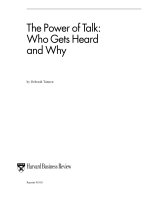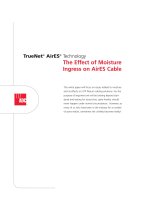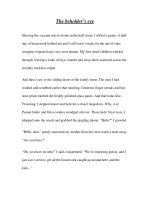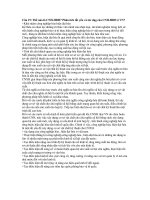Tài liệu The Online Disinhibition Effect BY JOHN SULER, Ph.D. pptx
Bạn đang xem bản rút gọn của tài liệu. Xem và tải ngay bản đầy đủ của tài liệu tại đây (100.35 KB, 7 trang )
The Online Disinhibition Effect
JOHN SULER, Ph.D.
ABSTRACT
While online, some people self-disclose or act out more frequently or intensely than they
would in person. This article explores six factors that interact with each other in creating this
online disinhibition effect: dissociative anonymity, invisibility, asynchronicity, solipsistic in-
trojection, dissociative imagination, and minimization of authority. Personality variables
also will influence the extent of this disinhibition. Rather than thinking of disinhibition as
the revealing of an underlying “true self,” we can conceptualize it as a shift to a constellation
within self-structure, involving clusters of affect and cognition that differ from the in-person
constellation.
321
CYBERPSYCHOLOGY & BEHAVIOR
Volume 7, Number 3, 2004
© Mary Ann Liebert, Inc.
INTRODUCTION
E
VERYDAY USERS on the Internet—as well as clini-
cians and researchers
1–7
—have noted how peo-
ple say and do things in cyberspace that they
wouldn’t ordinarily say and do in the face-to-face
world. They loosen up, feel less restrained, and ex-
press themselves more openly. So pervasive is the
phenomenon that a term has surfaced for it: the on-
line disinhibition effect.
This disinhibition can work in two seemingly op-
posing directions. Sometimes people share very
personal things about themselves. They reveal se-
cret emotions, fears, wishes. They show unusual
acts of kindness and generosity, sometimes going
out of their way to help others. We may call this be-
nign disinhibition.
However, the disinhibition is not always so salu-
tary. We witness rude language, harsh criticisms,
anger, hatred, even threats. Or people visit the dark
underworld of the Internet—places of pornogra-
phy, crime, and violence—territory they would
never explore in the real world. We may call this
toxic disinhibition.
Some types of benign disinhibition indicate an
attempt to better understand and develop oneself,
to resolve interpersonal and intrapsychic problems
or explore new emotional and experiential dimen-
sions to one’s identity.
8
We could even consider it a
process of “working through” as conceptualized in
psychodynamic theory, or “self-actualization” as
proposed in humanistic perspectives. By contrast,
toxic disinhibition may simply be a blind catharsis,
a fruitless repetition compulsion, and an acting out
of unsavory needs without any personal growth at
all.
9,10
As in all conceptual dichotomies, the distinction
between benign and toxic disinhibition will be
complex or ambiguous in some cases. For exam-
ple, hostile words in a chat encounter could be a
therapeutic breakthrough for some people. In an
increasingly intimate e-mail relationship, people
may quickly reveal personal information, then
later regret their self-disclosures—feeling exposed,
Department of Psychology, Rider University, Lawrenceville, New Jersey.
13658C03.PGS 6/15/04 2:36 PM Page 321
vulnerable, or shameful. An excessively rapid,
even false intimacy may develop, which later de-
stroys the relationship when one or both people
feel overwhelmed, anxious, or disappointed. Also,
in the very wide variety of online subcultures,
what is considered asocial behavior in one group
may be very à propos in another. Cultural relativ-
ity as well as the complexities of psychological dy-
namics will blur any simple contrasts between
disinhibition that is positive or negative.
Whether benign, toxic, or a mixture of both, what
causes this online disinhibition? What elements of
cyberspace lead to this weakening of the psycho-
logical barriers that block hidden feelings and
needs?
At least six factors are involved. For some peo-
ple, one or two of them produces the lion’s share of
the disinhibition effect. In most cases, however,
these factors intersect and interact with each other,
supplement each other, resulting in a more com-
plex, amplified effect.
DISSOCIATIVE ANONYMITY
As people move around the Internet, others they
encounter can’t easily determine who they are.
Usernames and e-mail addresses may be visible,
but this information may not reveal much about a
person, especially if the username is contrived and
the e-mail address derives from a large Internet ser-
vice provider. Technologically savvy, motivated
users may be able to detect a computer’s IP ad-
dress, but for the most part others only know what
a person tells them. If so desired, people can hide
some or all of their identity. They also can alter
their identities. As the word “anonymous” indi-
cates, people can have no name or at least not their
real name.
This anonymity is one of the principle factors
that creates the disinhibition effect. When people
have the opportunity to separate their actions on-
line from their in-person lifestyle and identity, they
feel less vulnerable about self-disclosing and acting
out. Whatever they say or do can’t be directly
linked to the rest of their lives. In a process of disso-
ciation, they don’t have to own their behavior by
acknowledging it within the full context of an inte-
grated online/offline identity. The online self be-
comes a compartmentalized self. In the case of
expressed hostilities or other deviant actions, the
person can avert responsibility for those behaviors,
almost as if superego restrictions and moral cogni-
tive processes have been temporarily suspended
from the online psyche. In fact, people might even
convince themselves that those online behaviors
“aren’t me at all.”
INVISIBILITY
In many online environments, especially those
that are text-driven, people cannot see each other.
When people visit web sites, message boards, and
even some chat rooms, other people may not even
know they are present at all—with the possible ex-
ception of web masters and other users who have
access to software tools that can detect traffic
through the environment, assuming they have the
inclination to keep an eye on an individual person,
who is one of maybe hundreds or thousands of
users.
This invisibility gives people the courage to go
places and do things that they otherwise wouldn’t.
Although this power to be concealed overlaps with
anonymity—because anonymity is the conceal-
ment of identity—there are some important differ-
ences. In the text communication of e-mail, chat,
instant messaging, and blogs, people may know a
great deal about each other’s identities and lives.
However, they still cannot see or hear each other.
Even with everyone’s identity known, the oppor-
tunity to be physically invisible amplifies the disin-
hibition effect. People don’t have to worry about
how they look or sound when they type a message.
They don’t have to worry about how others look or
sound in response to what they say. Seeing a frown,
a shaking head, a sigh, a bored expression, and
many other subtle and not so subtle signs of disap-
proval or indifference can inhibit what people are
willing to express. According to traditional psycho-
analytic theory, the analyst sits behind the patient
in order to remain a physically ambiguous figure,
revealing no body language or facial expression, so
that the patient has free range to discuss whatever
he or she wants without feeling inhibited by how
the analyst is physically reacting. In everyday rela-
tionships, people sometimes avert their eyes when
discussing something personal and emotional.
Avoiding eye contact and face-to-face visibility dis-
inhibits people. Text communication offers a built-
in opportunity to keep one’s eyes averted.
ASYNCHRONICITY
In e-mail and message boards, communication is
asynchronous. People don’t interact with each
other in real time. Others may take minutes, hours,
days, or even months to reply. Not having to cope
322 SULER
13658C03.PGS 6/15/04 2:36 PM Page 322
with someone’s immediate reaction disinhibits
people. In real life, the analogy might be speaking
to someone, magically suspending time before that
person can reply, and then returning to the conver-
sation when one is willing and able to hear the
response.
In a continuous feedback loop that reinforces
some behaviors and extinguishes others, moment-
by-moment responses from others powerfully
shapes the ongoing flow of self-disclosure and be-
havioral expression, usually in the direction of con-
forming to social norms. In e-mail and message
boards, where there are delays in that feedback,
people’s train of thought may progress more
steadily and quickly towards deeper expressions of
benign and toxic disinhibition that avert social
norms. Some people may even experience asyn-
chronous communication as “running away” after
posting a message that is personal, emotional, or
hostile. It feels safe putting it “out there” where it
can be left behind. In some cases, as Kali Munro, an
online psychotherapist, aptly describes it, the per-
son may be participating in an “emotional hit and
run” (K. Munro, unpublished observations, 2003).
SOLIPSISTIC INTROJECTION
Absent face-to-face cues combined with text
communication can alter self-boundaries. People
may feel that their mind has merged with the mind
of the online companion. Reading another person’s
message might be experienced as a voice within
one’s head, as if that person’s psychological pres-
ence and influence have been assimilated or intro-
jected into one’s psyche.
Of course, one may not know what the other per-
son’s voice actually sounds like, so in one’s mind a
voice is assigned to that person. In fact, consciously
or unconsciously, a person may even assign a visual
image to what he or she thinks the person looks and
behaves like. The online companion then becomes a
character within one’s intrapsychic world, a charac-
ter shaped partly by how the person actually pre-
sents him or herself via text communication, but
also by one’s internal representational system based
on personal expectations, wishes, and needs. Trans-
ference reactions encourage the shaping of this per-
ceived introjected character when similarities exist
between the online companion and significant oth-
ers in one’s life, and when one fills in ambiguities in
the personality of the online companion with im-
ages of past relationships, or from novels and film.
As the introjected character becomes more elaborate
and subjectively “real,” a person may start to expe-
rience the typed-text conversation as taking place
inside one’s mind, within the imagination, within
one’s intrapsychic world—not unlike authors typ-
ing out a play or novel.
Even when online relationships are not involved,
many people carry on these kinds of conversations
in their imagination throughout the day. People fan-
tasize about flirting, arguing with a boss, or hon-
estly confronting a friend about what they feel. In
their imagination, where it’s safe, people feel free to
say and do things they would not in reality. At that
moment, reality is one’s imagination. Online text
communication can evolve into an introjected psy-
chological tapestry in which a person’s mind
weaves these fantasy role plays, usually uncon-
sciously and with considerable disinhibition. Cy-
berspace may become a stage, and we are merely
players.
When reading another’s message, one might also
“hear” the online companion’s voice using one’s
own voice. People may subvocalize as they read,
thereby projecting the sound of their voice into the
other person’s text. This conversation may be expe-
rienced unconsciously as talking to/with oneself,
which encourages disinhibition because talking
with oneself feels safer than talking with others.
For some people, talking with oneself may feel like
confronting oneself, which may unleash many
powerful psychological issues.
DISSOCIATIVE IMAGINATION
If we combine the opportunity to easily escape or
dissociate from what happens online with the psy-
chological process of creating imaginary charac-
ters, we get a somewhat different force that
magnifies disinhibition. Consciously or uncon-
sciously, people may feel that the imaginary char-
acters they “created” exist in a different space, that
one’s online persona along with the online others
live in an make-believe dimension, separate and
apart from the demands and responsibilities of the
real world. They split or dissociate online fiction
from offline fact. Emily Finch, an author and crimi-
nal lawyer who studies identity theft in cyberspace,
has suggested that some people see their online life
as a kind of game with rules and norms that don’t
apply to everyday living (E. Finch, unpublished
observations, 2002). Once they turn off the com-
puter and return to their daily routine, they believe
they can leave behind that game and their game-
identity. They relinquish their responsible for what
happens in a make-believe play world that has
nothing to do with reality.
ONLINE DISINHIBITION EFFECT 323
13658C03.PGS 6/15/04 2:36 PM Page 323
The effect of this dissociative imagination sur-
faces clearly in fantasy game environments in
which a user consciously creates an imaginary
character, but it also can influence many dimen-
sions of online living. For people with a predis-
posed difficulty in distinguishing personal fantasy
from social reality, the distinction between online
fantasy environments and online social environ-
ments may be blurred. In our modern media-dri-
ven lifestyles, the power of computer and video
game imagination can infiltrate reality testing.
Although anonymity amplifies the effect of dis-
sociative imagination, dissociative imagination and
dissociative anonymity usually differ in the com-
plexity of the dissociated sector of the self. Under
the influence of anonymity, the person may at-
tempt an invisible non-identity, resulting in a re-
ducing, simplifying, or compartmentalizing of
self-expression. In dissociative imagination, the ex-
pressed but split-off self may evolve greatly in
complexity.
MINIMIZATION OF STATUS
AND AUTHORITY
While online a person’s status in the face-to-face
world may not be known to others and may not
have as much impact. Authority figures express
their status and power in their dress, body lan-
guage, and in the trappings of their environmental
settings. The absence of those cues in the text envi-
ronments of cyberspace reduces the impact of their
authority.
Even if people do know something about an au-
thority figure’s offline status and power, that ele-
vated position may have less of an effect on the
person’s online presence and influence. In many
environments on the Internet, everyone has an
equal opportunity to voice him or herself. Every-
one—regardless of status, wealth, race, or gender—
starts off on a level playing field. Although one’s
identity in the outside world ultimately may shape
power in cyberspace, what mostly determines the
influence on others is one’s skill in communicating
(including writing skills), persistence, the quality
of one’s ideas, and technical know-how.
People are reluctant to say what they really think
as they stand before an authority figure. A fear of
disapproval and punishment from on high damp-
ens the spirit. But online, in what feels more like a
peer relationship—with the appearances of author-
ity minimized—people are much more willing to
speak out and misbehave.
The traditional Internet philosophy holds that
everyone is an equal, that the purpose of the net is
to share ideas and resources among peers. The net
itself is designed with no centralized control, and
as it grows, with seemingly no end to its potential
for creating new environments, many of its inhabi-
tants see themselves as innovative, independent-
minded explorers and pioneers. This atmosphere
and this philosophy contribute to the minimizing
of authority.
INDIVIDUAL DIFFERENCES
AND PREDISPOSITIONS
The online disinhibition effect is not the only fac-
tor that determines how much people self-disclose
or act out in cyberspace. Individual differences play
an important role. For example, the intensity of a
person’s underlying feelings, needs, and drive level
affect susceptibility to disinhibition. Personality
styles also vary greatly in the strength of defense
mechanisms and tendencies towards inhibition or
expression. People with histrionic styles tend to be
very open and emotional, whereas compulsive peo-
ple are more restrained. The online disinhibition ef-
fect will interact with these personality variables, in
some cases resulting in a small deviation from the
person’s baseline (offline) behavior, while in other
cases causing dramatic changes. Future research
can focus on which people, under what circum-
stances, are more predisposed to the various ele-
ments of online disinhibition.
SHIFTS AMONG INTRAPSYCHIC
CONSTELLATIONS
We may be tempted to conclude that the disinhi-
bition effect releases deeper aspects of intrapsychic
structure, that it unlocks the true needs, emotions,
and self attributes that dwell beneath surface per-
sonality presentations. A man with repressed anger
unleashes his hostility online, thereby showing oth-
ers how he really feels. A shy woman openly ex-
presses her hidden affection for her cyberspace
companion. The fact that some people report being
more like their “true self” while online reinforces
this conceptual temptation. Inspired by Freud’s
archeological model of the mind, these ideas rest on
the assumption that personality structure is con-
structed in layers, that a core, true self exists be-
neath various layers of defenses and the more
superficial roles of everyday social interactions.
324 SULER
13658C03.PGS 6/15/04 2:36 PM Page 324
However, personal and cultural values deter-
mine what are considered the “true” aspects of
one’s personality. People more readily accept as
true those traits that are regarded as positive and
productive. However, self-centered sexual and ag-
gressive tendencies, as Freud noted, also are basic
components of personality dynamics, as are the
array of psychological defenses designed to control
them. Similarly, the seeming superficial social roles
of everyday living are necessary for functioning,
thereby serving a fundamental purpose in the psy-
chology of the individual. They are stable, valuable
aspects of identity.
The concept of disinhibition can lead us astray,
into thinking that what is disinhibited is a more
“true” aspect of identity than the processes of in-
hibiting and disinhibiting. But who or what is it
that does the inhibiting and disinhibiting? It is a
part or process within personality dynamics no less
real or important than other parts or processes.
This is why many psychoanalytic clinicians believe
that working with defenses and resistance—the in-
hibitors of the personality structure—is so crucial
to the success of the therapy. Even when therapy
reduces the intensity of these defenses, remnants of
them remain within the personality structure, serv-
ing an important regulatory function and some-
times evolving into productive aspects of one’s
personality independent of the affect or conflict
originally defended against.
The self does not exist separate from the environ-
ment in which that self is expressed. If someone
contains his aggression in face-to-face living, but
expresses that aggression online, both behaviors
reflect aspects of self: the self that acts non-
aggressively under certain conditions, the self that
acts aggressively under other conditions. When a
person is shy in person while outgoing online, nei-
ther self-presentation is more true. They are two di-
mensions of that person, each revealed within a
different situational context. Sometimes, as Jung
noted, these different sides of the person operate in
a dynamic polarity relative to each other. They are
two sides of the same personality dimension.
Instead of regarding the internal psychological
world as constructed in layers and juxtaposed with
an external environment, we can conceptualize it,
following traditional associationist theory, as an in-
trapsychic field containing clusters or constella-
tions of emotion, memory, and thinking that are
interconnected with certain environments. Some
constellations overlap, others are more dissociated
from each other, with environmental variables in-
fluencing those levels of integration and dissocia-
tion. Personality dynamics involve the complex in-
teractions among these facets of self and environ-
mental contexts.
The disinhibition effect can then be understood
as the person shifting, while online, to an intrapsy-
chic constellation that may be, in varying degrees,
dissociated from the in-person constellation, with
inhibiting guilt, anxiety, and related affects as fea-
tures of the in-person self but not as part of that
online self. This constellations model—which is
consistent with current clinical theories regarding
dissociation and information processing—helps ex-
plain the disinhibition effect as well as other online
phenomena, like identity experimentation, role
playing, multitasking, and other more subtle shifts
in personality expression as someone moves from
one online environment to another. In fact, a single
disinhibited “online self” probably does not exist at
all, but rather a collection of slightly different con-
stellations of affect, memory, and thought that sur-
face in and interact with different types of online
environments.
Different modalities of online communication
(e.g., e-mail, chat, video) and different environ-
ments (e.g., social, vocational, fantasy) may facili-
tate diverse expressions of self. Each setting allows
us to see a different perspective on identity. Neither
one is necessarily more true than another. Based on
a multidimensional analysis of the various psycho-
logical features of online settings, a comprehensive
theory on the psychotherapeutics of cyberspace can
explore how computer-mediated environments can
be designed to express, develop, and if necessary,
restrain different constellations of self-structure.
11,12
REFERENCES
1. Joinson, A. (1998). Causes and implications of disin-
hibited behavior on the Internet. In: Gackenbach, J.
(ed.), Psychology and the Internet: intrapersonal, inter-
personal, and transpersonal implications. San Diego: Ac-
ademic Press, pp. 43–60.
2. Joinson, A.N. (2001). Self-disclosure in computer-
mediated communication: the role of self-awareness
and visual anonymity. European Journal of Social Psy-
chology 31:177–192.
3. Leung, L. (2002). Loneliness, self-disclosure, and ICQ
(“I seek you”) use. CyberPsychology & Behavior
5:241–251.
4. Postmes, T., Spears, R., Sakhel, K., et al. (2001). Social
influence in computer-mediated communication:
The effects of anonymity on group behavior. Person-
ality & Social Psychology Bulletin 27:1243–1254.
ONLINE DISINHIBITION EFFECT 325
13658C03.PGS 6/15/04 2:36 PM Page 325
5. Suler, J.R. (2003). The psychology of cyberspace [On-
line]. Available: www.rider.edu/suler/psycyber/ psy-
cyber.html.
6. Fisher, W. A., & Barak, A. (2001). Internet pornogra-
phy: a social psychological perspective on Internet
sexuality. Journal of Sex Research 38:312–323.
7. King, S.A., & Barak, A. (1999). Compulsive Internet
gambling: a new form of an old clinical pathology.
CyberPsychology & Behavior 2:441–456.
8. Suler, J.R. (2002). Identity management in cyber-
space. Journal of Applied Psychoanalytic Studies 4:455–
460.
9. Suler, J.R. (1999). To get what you need: healthy and
pathological internet use. CyberPsychology & Behavior
2:385–394.
10. Suler, J.R., and Phillips, W. (1998). The bad boys of
cyberspace: deviant behavior in multimedia chat
communities. CyberPsychology & Behavior 1:275–
294.
11. Suler, J.R. (2000). Psychotherapy in cyberspace: a 5-
dimension model of online and computer-mediated
psychotherapy. CyberPsychology & Behavior 3:151–160.
12. Suler, J.R. (2001). The future of online clinical work.
Journal of Applied Psychoanalytic Studies 4:265–270.
Address reprint requests to:
John Suler, Ph.D.
Department of Psychology
Rider University
Lawrenceville, NJ 08648
E-mail:
326 SULER
13658C03.PGS 6/15/04 2:36 PM Page 326









